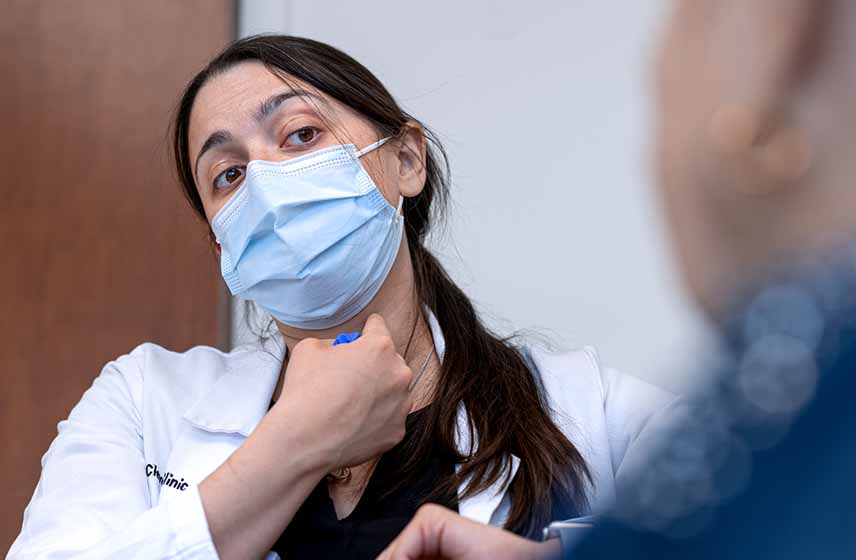
Spasmodic Dysphonia
It could be a cold. Or allergies. But if it doesn’t go away, it could be something called spasmodic dysphonia. This neurologic (nerve-related) speech condition causes the nerves and muscles that control your voice to tighten (spasm), shake (tremor), or get too loose when you’re talking. These changes can make your voice sound hoarse, strained, tight, shaky or even breathy. And because it doesn’t usually show up until mid-life (and doesn’t go away), you may feel a bit blindsided to learn you may have it.
While we don’t know exactly what causes spasmodic dysphonia, the experts at Cleveland Clinic know how to diagnose and treat it. We’ll work with you to find the best ways to manage ongoing symptoms and help your true voice — and confidence — shine through.
Why Choose Cleveland Clinic for Spasmodic Dysphonia Care?
Skilled, collaborative providers:
Treating spasmodic dysphonia requires a team approach. At Cleveland Clinic, your expert team will include providers from different specialties — all selected based on your unique needs and diagnosis.
Collaborative care:
Cleveland Clinic’s neurology, otolaryngology, and speech pathology providers regularly diagnose and treat problems with the nerves and muscles that power your voice. No matter how your voice changes begin, you can count on them to work together to find the best treatment for your specific symptoms. Meet our team.
Personalized care:
Every treatment path we take begins with listening to you. We understand that voice changes affect people in different ways. We create a personalized therapy plan that’s right for you and your needs.
Virtual visits:
Not all appointments need to be in person. Virtual visits let you meet one-on-one with your providers using a smartphone, tablet or computer. You can talk about your condition, how your treatment is going and any concerns you have from the comfort of your home.
National recognition:
Cleveland Clinic is a trusted healthcare leader. We're recognized in the U.S. and throughout the world for our expertise and care.
Spasmodic Dysphonia Diagnosis at Cleveland Clinic
When you talk or sing, your vocal cords vibrate inside your voice box (larynx) using the air coming from your lungs to create the sound of your voice. Changes in the nerves or the muscles that control your voice can cause different types of spasmodic dysphonia:
- Adductor spasmodic dysphonia: Your vocal cords spasm and tighten, causing your voice to sound strained, break or just stop when trying to talk. This is the most common type of spasmodic dysphonia.
- Abductor spasmodic dysphonia: Spasms in the nerves that open your vocal cords make them come apart when you talk, making your voice sound weak and breathy.
- Mixed spasmodic dysphonia: Spasms can make your vocal cords both too tight and too open, creating a mix of sounds. This is rare.
Spasmodic dysphonia can be tricky to diagnose because your larynx looks normal. And other conditions can have the same symptoms. That’s why it’s important to have experienced healthcare providers on your team. We’ll work with you to find out if you have spasmodic dysphonia and, if so, what kind.
What to expect at your first visit
When you first come to see us, we won’t jump right into testing. Your provider will want to get to know you first and hear your story. They may ask:
- When you first started noticing changes in your voice.
- What kind of changes they are.
- If the changes have gotten worse.
- If you have any other health conditions.
They’ll also do a physical exam, listen to your voice and check your throat to make sure everything else looks healthy.
Testing for spasmodic dysphonia
Our specialists may use videostroboscopy to see how your vocal cords are working. We numb your nose with medication. Then, we insert a small, flexible tube with a light and camera (endoscope) through your nose to view the inside of your throat. We have you make certain sounds while we record the video. The procedure doesn’t hurt and isn’t too uncomfortable.
Meet Our Spasmodic Dysphonia Team
At Cleveland Clinic, you may be seen by several different types of providers. They all play an important role in your diagnosis and treatment. Your care team may include:
Providers Who Treat Spasmodic Dysphonia
Locations
Our healthcare providers see patients at convenient locations throughout Northeast Ohio and Florida.Spasmodic Dysphonia Treatment at Cleveland Clinic
Spasmodic dysphonia is typically a lifelong condition. Symptoms may come and go regularly. Or there may be long pauses in between. And everyone experiences spasmodic dysphonia differently. So your care team will personalize your treatment plan to ease your specific symptoms and meet your needs and goals. They’ll also teach you the best ways to help manage this condition. Your treatment may include:
Anti-anxiety medications
If your dysphonia symptoms get worse when you’re under stress, we may treat you with anti-anxiety medications. These medications help control stress and reduce any anxiety you may feel about your speaking voice.
Injections
Our specialists may use Botox® (botulinum toxin) injections to help relax your vocal cords and improve dysphonia symptoms. You may need to have these injections every few months.
Manual therapy
We may recommend getting myofascial release therapy on the outside of your throat. Applying gentle pressure can help stretch the muscles and reduce spasms.
Voice therapy
Our speech-language pathologists use different voice therapy techniques to help control spasmodic dysphonia symptoms. We teach you exercises to:
- Control your breathing.
- Release tension.
- Strengthen your vocal cords.
Nerve surgery
If you have adductor spasmodic dysphonia, you may have selective laryngeal adductor denervation-reinnervation (SLAD-R). We make an incision (cut) to reach the nerves in your neck that control how your vocal cords move. We work to preserve your voice by cutting the nerves that are causing spasms and connecting unaffected nerves to your vocal muscles.
Vocal cord surgery
When other treatments don’t help spasmodic dysphonia symptoms, our experts may use thyroplasty to reposition your vocal cords. This surgery can help prevent the cords from closing too tightly or opening too much.
Taking the Next Step
Having problems with your voice can be stressful. It can affect your mood, your work life, your relationships and more. But with personalized treatment and caring support, your voice can get better. Our Cleveland Clinic specialists can help so you start feeling and sounding like yourself again.
Appointments
Getting an appointment with Cleveland Clinic’s spasmodic dysphonia experts is easy. We’re here to help you get care.
Billing & Insurance
Manage your Cleveland Clinic account. Find billing information and financial assistance, plus FAQs.
MyChart
Securely access your personal health information at any time, day or night.

